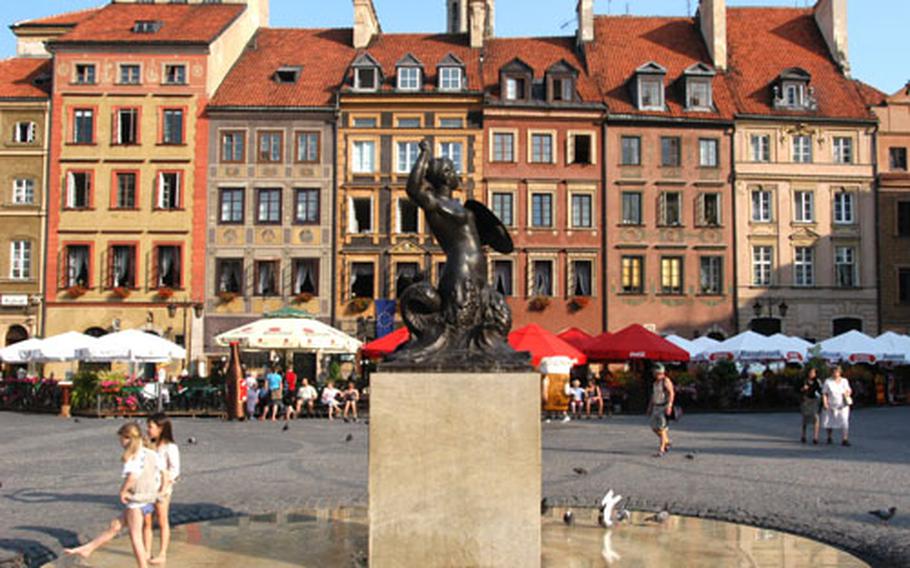
The head of the Serena monument in the center of the Old Market was modeled after Krystina Krahelska, a young Polish woman who died in the Warsaw uprising of World War II. (Peter Jaeger / S&S)
The Polish language can be a mouthful.
It isn’t every day someone gets to ask, “Which way to Krakowskie Przedmiescie?”
But that doesn’t mean a first-time visitor should be discouraged from going to Warsaw. A stroll through the Nowy Swiat shopping district and Old Town will make it worth the time.
Nowy Swiat (no-vee svyat) has wide, cobblestone sidewalks, cafés and boutiques. It’s small but offers prime shopping and people-watching. A few blocks away is Warsaw’s Old Town. It’s a 13th-century neighborhood that was destroyed in World War II and rebuilt. Old Town is the main tourist attraction in Warsaw.
Connecting Nowy Swiat to Old Town is the Royal Route, where tourists can admire the Presidential Palace, University of Warsaw, grand statues, churches and art galleries. It takes just 30 minutes to walk from one end of the Nowy Swiat to the other end of Old Town. But it’s a fun place to spend an entire day, or two.
Be forewarned that driving to Warsaw from Germany isn’t like swooping down the A-4 into Paris. It’s a trip better made by airplane or train. Most highways in Poland are just two lanes, and no one there is getting anywhere quickly.
Nowy Swiat
Nowy Swiat has been one of Warsaw’s fanciest neighborhoods since the Middle Ages. It’s taken a beating throughout the years from invaders ranging from the Swedes in the 17th century to the Nazis in World War II.
Still, it retains its swank image. Currently it’s the best place in Warsaw to buy a $500 pair of shoes or just sit with a drink at an outdoor café and watch the world pass by.
Just off of Nowy Swiat itself are smaller shops tucked into alleys and corners. There are street vendors hawking sandals, scarves, jewelry and whatever else they can purloin.
Here, goods can be cheap. An alley store was selling new CDs for 20 to 30 Polish zlotys (about $5 to $7.50).
Nowy Swiat is not a street of high-rises. It’s an elegant avenue of three-story buildings. The area is clean; there are always people picking up trash. It also feels safe. There seem to be two police officers to every block.
Parking does not seem to be a problem. On a recent Thursday afternoon, we found a good on-street spot after just a few minutes of hunting. The fee was about $3 for six hours (and parking overnight was free).
Nowy Swiat is not a haven for beggars. For the few who are there, a little pocket change goes a long way. Tourists can always dump their last few zloty coins before heading out of town. They won’t be worth much elsewhere — one is worth about 25 cents in U.S. currency.
The Royal Route
The name of the street connecting Nowy Swiat with the Old Town is “Krakowskie Przedmiescie.” The tourist guides simply call the street the “Royal Route.” It’s a short walk rich in touristy trinkets. The University of Warsaw is on this street, so it usually is crowded with young people.
Like other European cities, Warsaw is big on art and statues — big statues — that honor its heroes. On the Royal Route, there’s one of Josef Poniatowski, who led his troops against Austria in 1809. There’s a 20-foot statue of Stefan Cardinal Wyszynski, the leader of Poland’s Catholic Church for much of the 20th century. And who can forget Nicolas Copernicus, the father of modern astronomy? In 1530 he radically theorized that the sun — not the earth — was at the center of the universe. He is honored with a monument, too.
If you prefer your dignitaries to be living, you can see the house of Aleksander Kwasniewski, the president of Poland. The Presidential Palace is the huge, white place you’ll see just before you reach Old Town. You can’t miss it — it’s the one with the soldiers standing guard outside.
Old Town
Walking at night through Warsaw’s Old Town is like having a slice of history all to one’s self. It’s eerily quiet. On its darkened streets can be heard the clip-clop of heels on cobblestone. The Old Town is small-town quaint but vast enough for someone to get lost in.
Ornamental street lamps throw highlights onto the narrow, stone walkways and up onto the walls of the brownstone buildings. Stone archways greet visitors who turn the corner to walk down a street. People live in Old Town’s ancient apartments.
The Old Town is an especially warm, comforting place to go for a walk on a summer night. And one can imagine its beauty in winter: Under a coat of snow, a horse-drawn sleigh would look right at home. On a recent Thursday night, when it seemed as if Old Town was almost deserted, a visitor stumbled upon a town square with biergartens and restaurants teeming with people. There must have been 1,000 people dining, drinking and talking softly. There was no music playing. People’s faces were beaming but the atmosphere at midnight on the Old Town square was mellow.
Who knew so many people could be so … respectful?